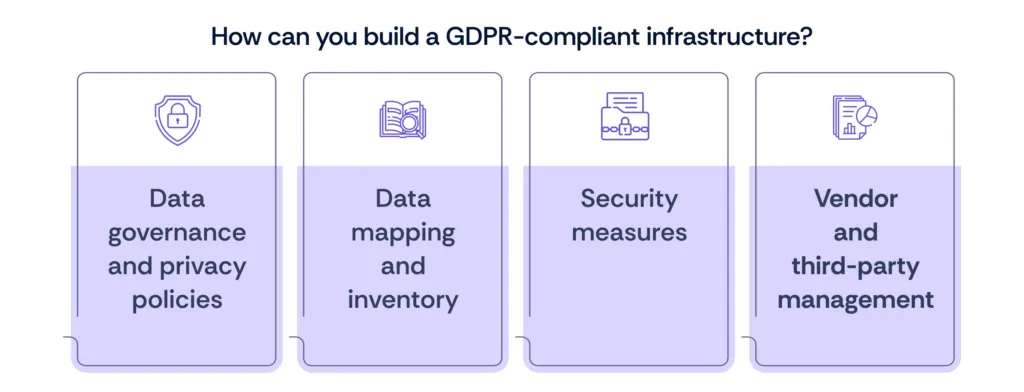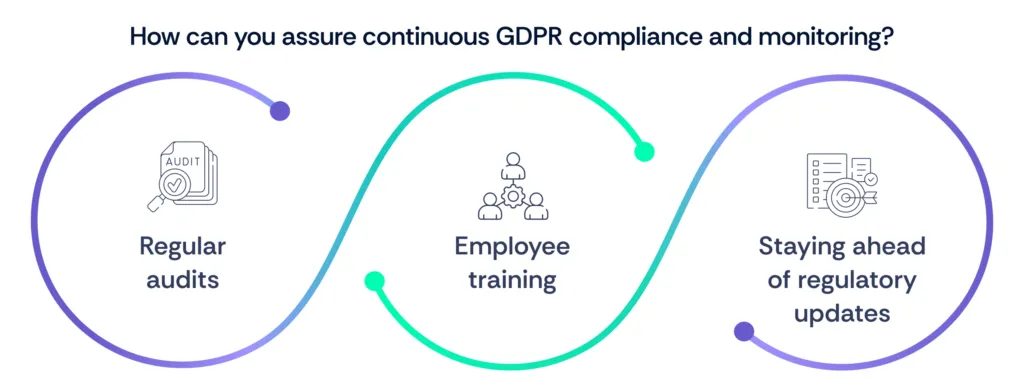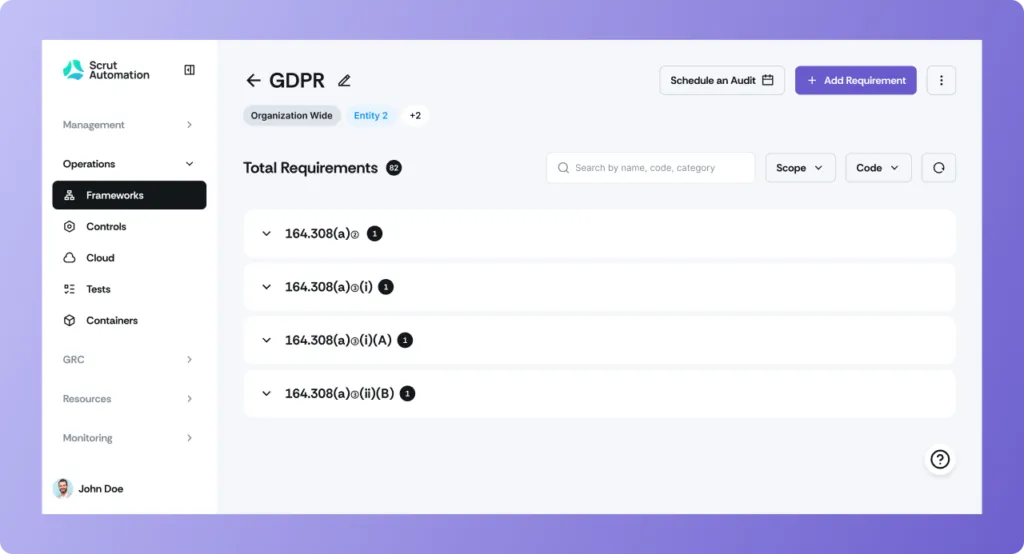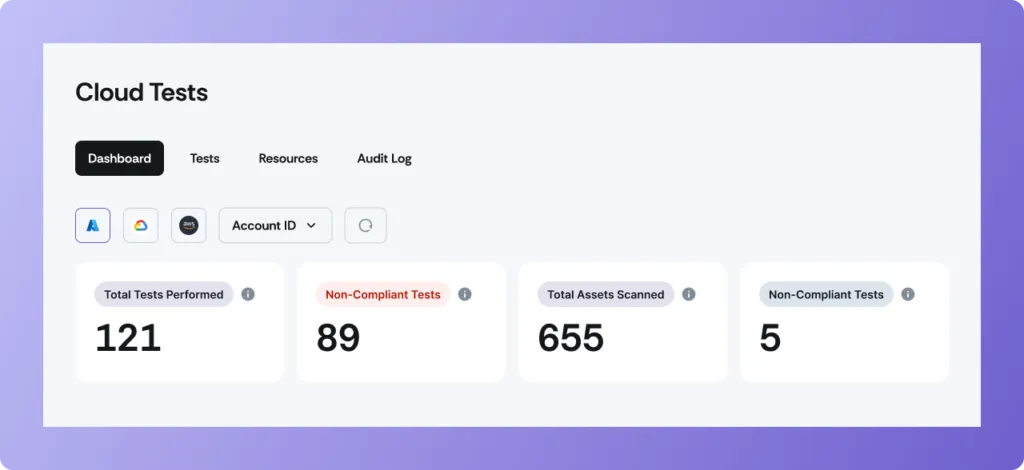GDPR for dummies: Strategies for compliance

The rapid rise of technology and data-driven models has made GDPR compliance essential for protecting personal data. For CEOs and CISOs, understanding what GDPR entails and adhering to its principles is both a legal requirement and a strategic priority. Non-compliance risks include hefty fines, reputational damage, and operational setbacks.
To ensure GDPR compliance, decision-makers must embed GDPR principles into their organizations' core operations. This involves obtaining the necessary GDPR certification, adopting robust data protection measures, and fostering a culture of privacy. By doing so, businesses not only reduce risks but also build trust with customers and stakeholders.
Understanding GDPR might seem daunting but for those starting out, "GDPR for dummies" resources can provide a clear and simplified approach to these complex regulations.
The GDPR framework: A quick refresher
What is GDPR?
The General Data Protection Regulation (GDPR) is a comprehensive data privacy law enacted by the European Union (EU) that governs how the personal data of EU citizens is collected, processed, and stored.
Effective since May 25, 2018, the GDPR aims to give individuals greater control over their personal information and establish stringent standards for data protection across EU member states.
Since its enforcement in 2018, GDPR has reshaped data protection practices across GDPR-certified organizations in multiple countries. As of 2024, over 2086 fines have been issued, totaling €4.48 billion, with the €1.2 billion penalty against Meta in 2023 underscoring the risks of non-compliance. Beyond financial penalties, GDPR impacts business operations, with studies showing an 8% drop in revenue for websites failing to comply with its requirements.
Key principles
GDPR compliance revolves around seven core principles that provide a strong foundation for organizations aiming to achieve GDPR certification. For organizations struggling with these concepts, diving into "GDPR for dummies" guides can be a helpful starting point to break down the fundamental principles.
- Lawfulness, fairness, and transparency: Organizations must handle personal data lawfully, fairly, and transparently.
- Purpose limitation: Data should only be collected for specific, explicit, and legitimate purposes.
- Data minimization: Only the data necessary for achieving a stated purpose should be processed.
- Accuracy: Personal data must be accurate and kept up to date.
- Storage limitation: Retain personal data only for as long as it is necessary.
- Integrity and confidentiality: Ensure appropriate security to protect data from breaches or unauthorized access.
- Accountability: Organizations must demonstrate compliance with GDPR principles through documentation and proactive measures.
These principles are the cornerstone of what GDPR aims to achieve: protecting the rights and freedoms of individuals across GDPR countries.
Read also: Debunking five common GDPR compliance myths
Applicability for GDPR certification
- Which businesses must comply?
GDPR applies to any organization that processes the personal data of individuals within the European Union (EU) and European Economic Area (EEA), regardless of whether the organization is based in those physical areas. Achieving GDPR certification ensures businesses meet these standards globally. - Cross-border implications for non-EU companies:
Even non-EU businesses must adhere to GDPR if they process or monitor the data of EU residents. For instance, companies outside the EU providing goods or services to EU individuals must align with GDPR compliance, particularly when handling cross-border data transfers.
The GDPR framework ensures consistency in data protection practices across GDPR countries, fostering trust and accountability in a globalized world.
Read also: Does your business need to comply with GDPR?
Why GDPR compliance is critical
Consequences of non-compliance
Failing to meet GDPR compliance requirements can have far-reaching consequences, including:
- Fines and sanctions (Article 83 penalties): GDPR violations can result in fines of up to €20 million or 4% of a company's annual global turnover, whichever is higher.
- Brand and reputational risks: Non-compliance damages trust with customers and stakeholders, leading to loss of business and long-term brand erosion.
For example, in August 2024, Uber faced a €290 million fine from the Dutch Data Protection Authority for violating the GDPR. The penalty was imposed due to Uber's unauthorized transfer of European drivers' personal data to the United States without adequate safeguards. This incident underscores the critical importance of adhering to GDPR principles, particularly regarding cross-border data transfers and the protection of personal information. It has raised concerns among users and stakeholders about Uber's commitment to data privacy and security, potentially eroding trust and affecting customer loyalty.
The above example underscores how GDPR non-compliance can severely impact brand reputation, especially for businesses in competitive industries where consumer trust is crucial.
Positive outcomes of compliance
Investing in GDPR certification and maintaining compliance brings several advantages:
- Trust building with customers and stakeholders: Demonstrating adherence to GDPR principles reassures individuals that their personal data is protected, fostering loyalty and confidence in the brand.
- Competitive advantage in privacy-conscious markets: Organizations that align with GDPR requirements stand out in markets where data protection is a key consumer priority, gaining an edge over competitors.
- Enhanced cybersecurity posture: Compliance with GDPR mandates, such as securing personal data and monitoring for breaches, strengthens overall cybersecurity and reduces exposure to threats.
In a world increasingly focused on privacy and data security, ensuring compliance with GDPR mitigates risks and positions businesses as leaders in GDPR-compliant markets globally.
Read also: GDPR cookie consent: Requirements & how to comply?
Key GDPR compliance requirements

Ensuring GDPR compliance involves adhering to a range of obligations across data processing, transparency, and security measures. Below is a breakdown of the critical requirements:
1. Data processing obligations
To align with GDPR principles, organizations must ensure the following:
- Lawful basis for processing: Every data processing activity must be based on one of six lawful bases, such as consent, contract performance, or legitimate interests.
- Consent management: Consent must be freely given, specific, informed, and unambiguous, with easy options for withdrawal.
- Special categories of data: Additional safeguards are required when processing sensitive data such as health records, biometric data, or political opinions.
2. Transparency and rights
GDPR emphasizes transparency and empowering individuals with control over their data:
- Privacy notices: Clear, concise, and accessible information must be provided about how personal data is collected, used, and shared.
- Individual rights: Organizations must honor key data subject rights, including access to data, rectification of inaccuracies, erasure (right to be forgotten), data portability, and the right to restrict or object to processing.
3. Data Protection Impact Assessments (DPIAs)
DPIAs are essential for assessing risks associated with data processing activities:
- When required: DPIAs are mandatory when processing is likely to result in a high risk to individuals' rights and freedoms (e.g., large-scale monitoring or use of new technologies).
- How to conduct: A DPIA must evaluate risks, assess measures to mitigate those risks and document the findings to demonstrate accountability.
4. Record keeping
Documentation is a key part of GDPR's accountability principle:
- Processing activities: Organizations must maintain a detailed record of processing activities (ROPA), including data categories, purposes, and any data sharing.
- Retention policies: Clear timelines for data storage and secure deletion must be established.
5. Incident response
GDPR mandates swift action in the event of a data breach:
- 72-hour breach notification rule: Organizations must report data breaches to the relevant supervisory authority within 72 hours of becoming aware, detailing the scope, impact, and mitigation steps.
By meeting these requirements, businesses across GDPR countries can work toward achieving GDPR certification, building trust, and avoiding non-compliance risks.
Read also: Why GDPR compliance goes beyond a CISO's agenda?
Building a GDPR-compliant infrastructure

Creating a GDPR-compliant infrastructure is essential for organizations operating across GDPR countries or handling EU residents' personal data. Even as businesses implement sophisticated tools like Scrut Automation, combining these efforts with basic "GDPR for dummies" insights ensures a well-rounded understanding for teams unfamiliar with compliance.
1. Data governance and privacy policies
A strong governance framework is the backbone of GDPR compliance:
- Develop and implement clear data handling policies aligned with GDPR principles, including guidelines for collection, processing, and retention.
- Regularly update privacy policies to reflect regulatory changes and ensure they are easily accessible and transparent for stakeholders.
2. Data mapping and inventory
It is essential to have a clear understanding of your data environment:
- Conduct thorough data mapping to identify all personal data you process, including its sources, locations, and flows within and outside the organization.
- Maintain a detailed data inventory to track processing purposes, lawful bases, and retention periods. This documentation supports compliance and facilitates GDPR certification efforts.
3. Security measures
Robust security is non-negotiable for GDPR compliance:
- Encryption and pseudonymization: Protect sensitive data during storage and transmission by encrypting it or replacing identifiers with pseudonyms.
- Access controls: Implement strict role-based access to ensure only authorized personnel can access personal data.
- Monitor and regularly test security systems to prevent breaches and identify vulnerabilities.
4. Vendor and third-party management
GDPR requires organizations to ensure compliance across their supply chain:
- Vet processors and sub-processors to confirm they meet GDPR standards, especially when processing personal data on your behalf.
- Establish GDPR-compliant contracts with vendors, outlining roles, responsibilities, and breach notification procedures.
- Conduct regular audits of third parties to ensure they maintain proper data protection measures.
Integrating these elements enables a GDPR-compliant infrastructure that safeguards data, boosts efficiency, builds stakeholder trust, and ensures success in privacy-focused markets.
Read also: How GDPR affects Marketing
Appointing a Data Protection Officer (DPO)
A Data Protection Officer (DPO) plays a critical role in ensuring GDPR compliance across an organization. Here's an overview of when you need a DPO, their responsibilities, and the options for appointing one.
Who Needs a DPO?
Under Articles 37-39 of the GDPR, appointing a DPO is mandatory for certain organizations:
- Public authorities: Any organization acting as a public body (excluding courts acting in a judicial capacity).
- Core activities involving large-scale monitoring: Businesses that systematically monitor individuals, such as behavioral tracking or processing sensitive personal data on a large scale.
- Core activities involving special categories of data: Organizations handling data such as health records, biometrics, or criminal convictions must appoint a DPO.
Even if not legally required, appointing a DPO is recommended for companies operating in GDPR countries to demonstrate accountability and strengthen data protection practices.
Role and responsibilities of the DPO
The DPO is central to maintaining a GDPR-compliant infrastructure:
- Ensuring compliance: Advise the organization on adhering to GDPR principles and ensure activities align with legal obligations.
- Conducting audits: Regularly audit data protection policies, systems, and processes to identify risks and areas for improvement.
- Training employees: Educate staff on their responsibilities under GDPR, fostering a culture of privacy and accountability.
- Point of contact: Act as the intermediary between the organization, supervisory authorities, and individuals regarding data protection matters.
DPO outsourcing options
Organizations can choose between hiring an in-house DPO or outsourcing the role:

Whether in-house or outsourced, appointing a qualified DPO strengthens organizational accountability, ensuring adherence to GDPR principles and enhancing trust with stakeholders.
Listen to: Compliance Beyond the Checkbox: A Fresh Perspective on Auditors and Risk
GDPR compliance for emerging technologies
As emerging technologies like AI, IoT, and big data reshape industries, ensuring GDPR compliance becomes increasingly complex. Here's how organizations can address privacy and security challenges in these innovative domains:
1. AI and data privacy
Artificial intelligence introduces unique challenges in managing data subject rights under GDPR principles:
- Transparency in AI processing: Organizations must explain how personal data is used in AI models. GDPR requires transparency, even for complex machine learning algorithms.
- Managing data subject rights: AI applications must respect rights like data access, rectification, and erasure. For instance, if an AI algorithm makes automated decisions, users have the right to request human intervention and explanation under GDPR Article 22.
- Data minimization: Limit data collection to what is necessary for AI training while adhering to what GDPR defines as lawful data usage.
2. IoT and big data challenges
IoT devices and big data systems often process vast amounts of personal information, creating challenges for GDPR compliance:
- Data security: Highly interconnected systems increase the risk of breaches. Strong encryption, access controls, and regular security audits are essential.
- Consent in IoT: Devices must obtain explicit, informed consent from users for data collection, especially when sensitive personal data is involved.
- Data mapping: With data flowing across various devices, maintaining an accurate inventory of where personal data resides is crucial to meeting GDPR certification requirements.
3. Cross-regulation synergy
Aligning GDPR with other regulatory frameworks ensures comprehensive compliance:
- NIST: The National Institute of Standards and Technology provides guidelines for managing cybersecurity risks that complement GDPR's data protection requirements.
- ISO 27001: ISO 27001, an international standard for information security management, aligns well with GDPR by addressing data security and breach prevention.
- DORA (Digital Operational Resilience Act): For financial institutions, aligning GDPR principles with DORA ensures operational resilience while meeting privacy regulations across GDPR countries.
Organizations working with emerging technologies must embed GDPR-compliant practices into their systems, fostering trust while balancing innovation and privacy.
Read also: Automation in GDPR Compliance: Chasing Efficiency and Accuracy
Ongoing GDPR compliance and monitoring

Ensuring GDPR compliance is not a one-time task; it requires continuous effort to adapt and respond to evolving requirements and risks. Here's how organizations can maintain compliance over time:
1. Regular audits
Conducting regular audits is essential for monitoring compliance with GDPR principles and identifying potential risks:
- Frequency and scope:
- Audits should be conducted at least annually or more frequently for high-risk data processing activities.
- The scope should include data processing activities, documentation (e.g., records of processing activities or ROPAs), security measures, and incident response protocols.
- Documentation: Comprehensive records from audits demonstrate accountability and support efforts toward achieving or maintaining GDPR certification.
2. Employee training
Building a culture of privacy is critical for sustained compliance:
- Privacy and security awareness: Regular training sessions should educate employees on GDPR requirements, including data handling, breach reporting, and respecting individual rights.
- Role-specific training: Tailor training for different roles, such as specialized guidance for IT teams on encryption or for marketing teams on lawful data collection.
- Continuous learning: Keep employees updated on new GDPR guidelines or changes in enforcement trends across GDPR countries.
3. Staying ahead of regulatory updates
GDPR enforcement evolves as technology and global privacy norms change:
- Monitor updates: Stay informed about new rulings, enforcement trends, or guidance issued by the European Data Protection Board (EDPB) or national authorities.
- Adapt quickly: Update policies, contracts with third parties, and data protection measures to align with new interpretations or amendments to what GDPR requires.
- Cross-border implications: For businesses operating globally, track developments that may impact data flows between GDPR countries and non-EU regions (e.g., updates to adequacy decisions or the latest Schrems rulings).
By embedding these practices into daily operations, organizations can maintain robust GDPR compliance, build trust with stakeholders, and proactively manage regulatory risks in a dynamic privacy landscape.
Read also: Best Practices for Automating GDPR Compliance
How can Scrut help you in GDPR compliance?
Scrut Automation offers a comprehensive platform designed to streamline and enhance GDPR compliance for organizations. Key features include:
- Centralized compliance management: Scrut provides a single-window platform to manage all GDPR-related policies, tasks, and evidence, simplifying the compliance process.

- Pre-built policy hub: Access over 50 expert-vetted GDPR-compliant policies to quickly establish a robust data protection framework.

- Automated cloud scanning: The platform performs continuous scanning across AWS, Azure, and GCP, identifying misconfigurations against GDPR guidelines to ensure data security.

- Evidence collection automation: Scrut integrates with over 70 tools to automate evidence collection, reducing manual effort and ensuring readiness for audits.

- Audit collaboration center: Facilitate seamless collaboration with auditors through Scrut's GDPR Audit Centre, streamlining the audit process.

- Continuous compliance monitoring: Benefit from 24×7 monitoring to manage daily compliance tasks and maintain a strong compliance posture.
By leveraging Scrut's platform, organizations can efficiently achieve and maintain GDPR compliance, mitigating risks and building trust with customers and stakeholders.
Read also: GDPR vs HIPAA compliance: What's the difference?
Case studies and best practices
Implementing GDPR compliance effectively is crucial for organizations to protect personal data and maintain trust. Examining both success stories and lessons from non-compliance offers valuable insights.
Success stories:
Qapita, a Singapore-based equity management SaaS platform, successfully streamlined its GDPR compliance using Scrut's smartGRC platform. By automating cloud infrastructure monitoring and evidence collection, Qapita achieved continuous compliance and audit readiness.
Similarly, TraceX, an India-based blockchain-powered digital agriculture platform, leveraged enhanced cloud risk observability through Scrut to streamline GDPR compliance. This approach enabled TraceX to build a robust information security posture aligned with GDPR standards.
Practical insights
By addressing these pitfalls, organizations can strengthen their GDPR compliance strategies, reduce risks, and build trust in privacy-conscious markets.

Closing thoughts
As technology continues to evolve, GDPR compliance remains a cornerstone for safeguarding personal data and fostering trust in privacy-conscious markets. Whether you're a seasoned expert or just starting, resources like "GDPR for dummies" can help simplify the path to compliance, making it accessible to every stakeholder in your organization.
For CEOs and CISOs, it's clear that embedding GDPR principles into organizational operations is not just a regulatory requirement but a strategic advantage.
From understanding key compliance requirements to leveraging tools like Scrut Automation, organizations can efficiently navigate the complexities of what GDPR demands, reducing risks and enhancing their reputation.
Achieving and maintaining GDPR compliance is not merely about meeting legal obligations—it's about building a foundation for sustainable success in an increasingly privacy-focused world.
Ensure GDPR compliance with ease using Scrut Automation
Achieving and maintaining GDPR compliance doesn't have to be overwhelming. With Scrut's smartGRC platform, you can streamline your compliance efforts, automate evidence collection, and ensure continuous monitoring to stay ahead of regulatory requirements.
FAQs
What is GDPR certification, and why is it important? GDPR certification is a formal recognition that an organization complies with the General Data Protection Regulation (GDPR) requirements, helping build trust and demonstrate accountability in handling personal data.
How can my business achieve GDPR certification? Businesses can achieve GDPR certification by aligning with GDPR principles, conducting data protection audits, implementing security measures, and working with an accredited certification body.
What are the benefits of obtaining GDPR certification? Benefits include enhanced trust with customers, a competitive edge in privacy-conscious markets, reduced risk of non-compliance penalties, and improved overall data security.
What are the key requirements for GDPR certification compliance? Key requirements include adherence to GDPR principles, maintaining detailed records of processing activities, conducting Data Protection Impact Assessments (DPIAs), ensuring data security, and appointing a


















